- 154 Disinformation Cases Found in 36-Day Movement
- The highest amount of disinformation spread on July 18
- Disinformation on martyrs, leaders
- Disinformation Spread from Responsible Sources
- Fact-checking Disrupted by Internet Shutdown
- Disinformation Spread on Protest Continues
On August 5, 2024, as morning turned to afternoon, the “March to Dhaka” protest was happening. More and more people were gathering on the streets.
Suddenly, news spread that Sheikh Hasina had resigned. A picture was sent to Rumor Scanner showing a helicopter ready to take off, with luggage and two cars in front of it. Some people, including members of the Special Security Force (SSF) who protected the Prime Minister, were also in the picture. Unconfirmed sources were saying that Sheikh Hasina had left Bangladesh.
Just after 3 PM, Rumor Scanner confirmed that the Awami League government, which had been in power for 15 years, had fallen because of a massive protest by students and the public. Sheikh Hasina had left the country.
This movement started with a demand to reform the government job quota system and grew into a bigger call for change after many days of clashes and deaths. Looking back, fake news was a constant part of the movement. Rumor Scanner worked tirelessly to fight against this disinformation during that time.
Over 150 Disinformation Cases During Movement Days
Last year, a protest started on June 5th to demand changes to the government’s job quota system. In July, students from Dhaka University formed the ‘Anti-Discrimination Student Movement’ and held a rally at TSC (Teacher-Student Centre). They were demanding that the government cancel the quota system and bring back the 2018 government notice that had removed it. The protesters set a deadline for their demands to be met by July 4th. But on that day, the High Court’s decision to cancel the 2018 circular wasn’t put on hold, which angered the students. As a result, they intensified their protests across the country.
It was on this very day that Rumor Scanner first spotted a piece of disinformation about the protest. A digital banner claimed that Rashed Khan, the former acting convenor of the 2018 quota reform movement and general secretary of the Gono Odhikar Parishad, had said something about the protest. The quote on the banner was: “This quota protest has given me lakhs of followers on Facebook and YouTube. I can earn money anytime through bKash/Nagad. So, I don’t feel like getting a job.”
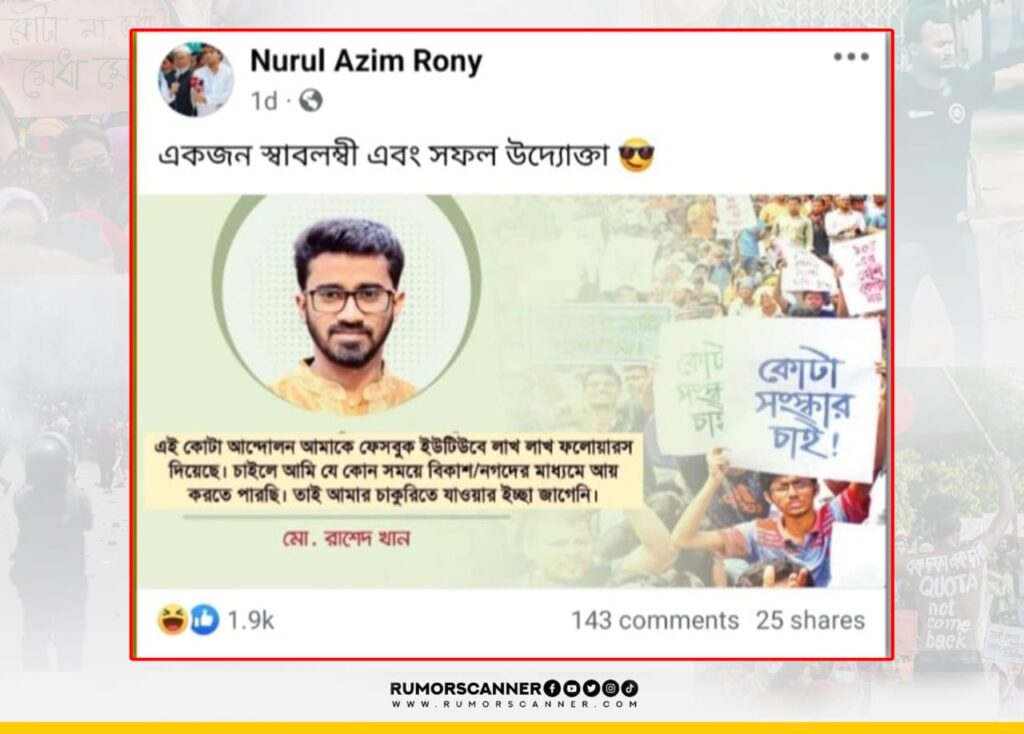
However, Rumor Scanner checked and found that Rashed Khan had never made that statement. The quote was actually a funny, edited version of a comment he made in a completely different situation, which was published on the Jagonews24 website. At first, it was shared as a joke, but later, many people started spreading it as if it were true.
The protests continued in the following days. On July 11, students from Comilla University were blocked by police while trying to march to the Dhaka-Chittagong highway. There was a chase between the police and students, and at least 20 people, including students, were injured. That same day, the first rumor of a death in the movement began to spread.
Rumor Scanner confirmed that there were no deaths in the protest until July 15. The first confirmed death happened on July 16, when Abu Sayed, a student from Begum Rokeya University, was killed by police fire in Rangpur. That same day, a picture of another student from Rangpur named Miftahul Jannat Mita was shared, claiming she was the second person to die. But her older sister told Rumor Scanner that Mita was only injured and later recovered.
After July 16, the protests became more violent as law enforcement and government party members tried to stop them. This led to many deaths and thousands of injuries. Throughout this time, disinformation was a constant companion. From July 15 to the end of the month, and even up until the fall of Sheikh Hasina on August 5, Rumor Scanner was busy identifying fake news about the protests. Over those 36 days, Rumor Scanner found and exposed 154 pieces of disinformation.

Disinformation reached its peak on July 18th, with 17 pieces of fake news spreading on that single day. This was during a “complete shutdown” protest that led to violent clashes, police shootings, and attacks across 48 districts, including Dhaka. At least 42 people, including Mir Mahfuzur Rahman Mugdho, were killed. A significant amount of disinformation was also shared in the final three days before Sheikh Hasina’s resignation. On August 2nd, following a call from the Anti-Discrimination Student Movement, a “Prayer and Mass Procession” was held in at least 28 districts after Friday prayers. The next day, Bangladesh was swept by protests demanding the resignation of the Awami League government, with thousands gathering at the Central Shaheed Minar in Dhaka. An all-out non-cooperation movement started on August 4th with the same demand, and according to the newspaper Prothom Alo, 114 people died on this day. In just these three days, we found evidence of 43 pieces of disinformation being spread.
Nature of Disinformation Shifted Over Time
Based on Rumor Scanner’s analysis, the type of disinformation spread during the July protests changed over time. In the beginning, when the protests involved demonstrations, blockades, and class boycotts, there wasn’t a lot of disinformation. However, that changed on July 11th, when the movement started to become violent. This is when fake claims of deaths began to appear.
Until July 15, clashes occurred between students and the banned organization Chhatra League and the police in various parts of the country, including Dhaka, Cumilla, and Chattogram. Students became especially angry after a press conference on July 14th where Sheikh Hasina commented on her trip to China. This fueled the protests, and students took to the streets. The next day, the Chhatra League attacked protesters in several locations. Although there were no deaths, fake news spread, claiming a total of 13 people had died.
The first actual death in the movement happened on July 16th. After this, news of deaths was reported almost daily by the media. Once real deaths were confirmed, the fake claims of deaths among protesters started to decrease. Interestingly, while the initial fake news was about protesters dying, the disinformation later shifted to include fake deaths of people on the government’s side. For example, on July 16th, Rumor Scanner received claims that at least two Chhatra League leaders had died, but both of these claims were verified to be false.
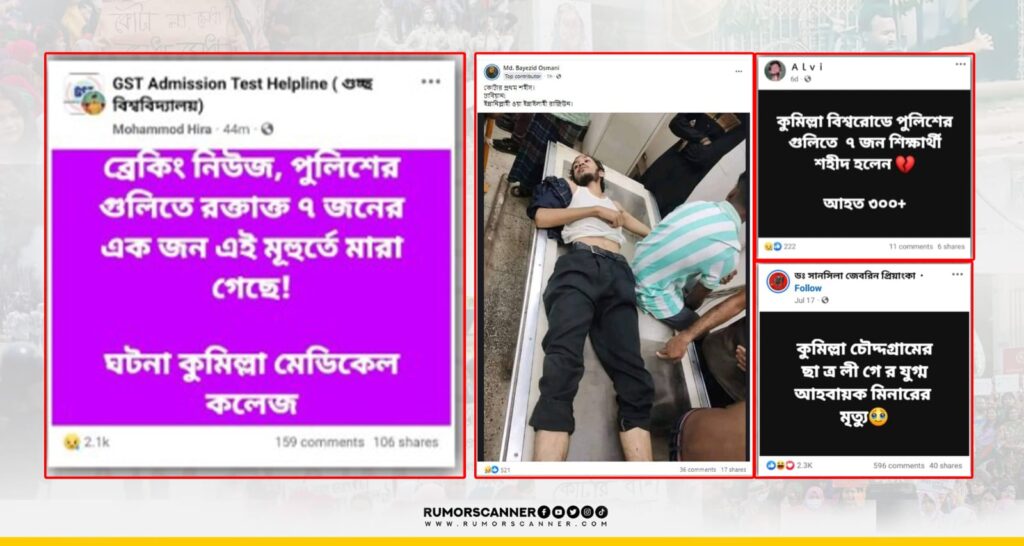
On July 16, a video went viral showing people being thrown from a building’s rooftop. The claim was that Chhatra League members were throwing students off the roof. However, an investigation revealed the opposite was true: protesting students in Chattogram were actually throwing Chhatra League workers from the building.
The day before, a photo of a female student from Dhaka University went viral on Facebook with claims that she had been killed in an attack by the Chhatra League. Rumor Scanner checked this and found that the student, Sanjida Ahmed Tonni, was indeed injured in the violence but had later recovered and was well.
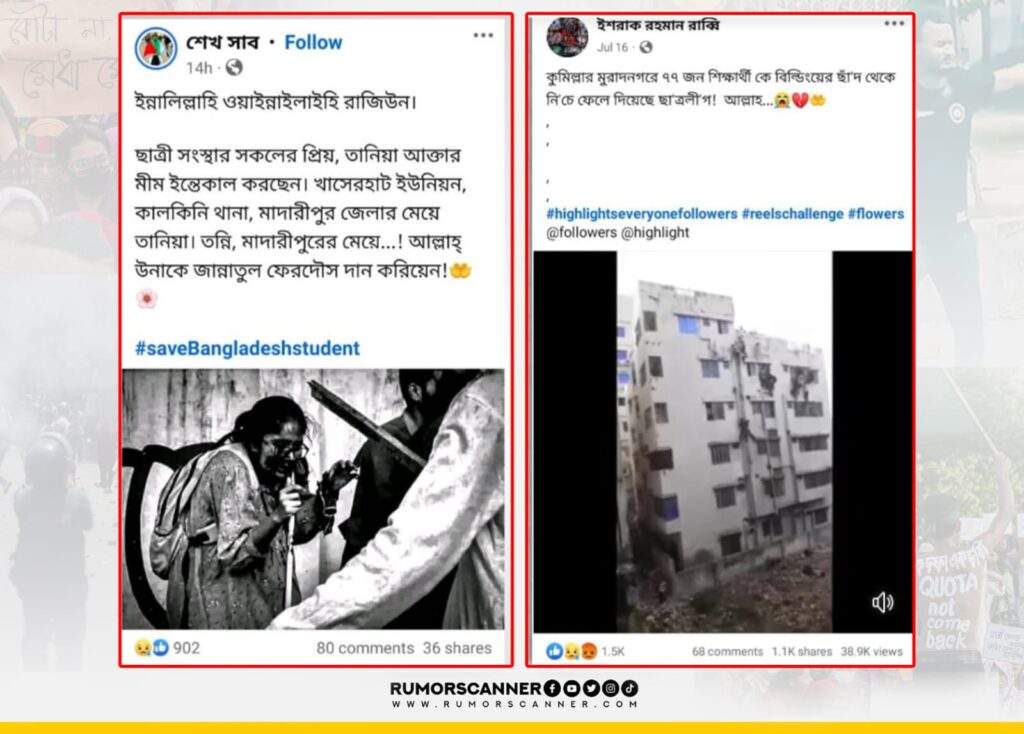
Disinformation about the death toll also involved fake claims that cited media outlets. On July 22, it was falsely claimed that 900 people had died in the protests. On July 24, this number was raised to over 1,700, with the national newspaper Prothom Alo cited as the source. However, at that time, Prothom Alo’s reporting only mentioned 204 deaths. Additionally, on July 22, another claim spread, citing the national newspaper KalBela, saying that 100 students’ bodies had been found in Dhaka’s Hatirjheel lake. When this claim was checked, it was found that the video used to support it was old and from a completely different event.
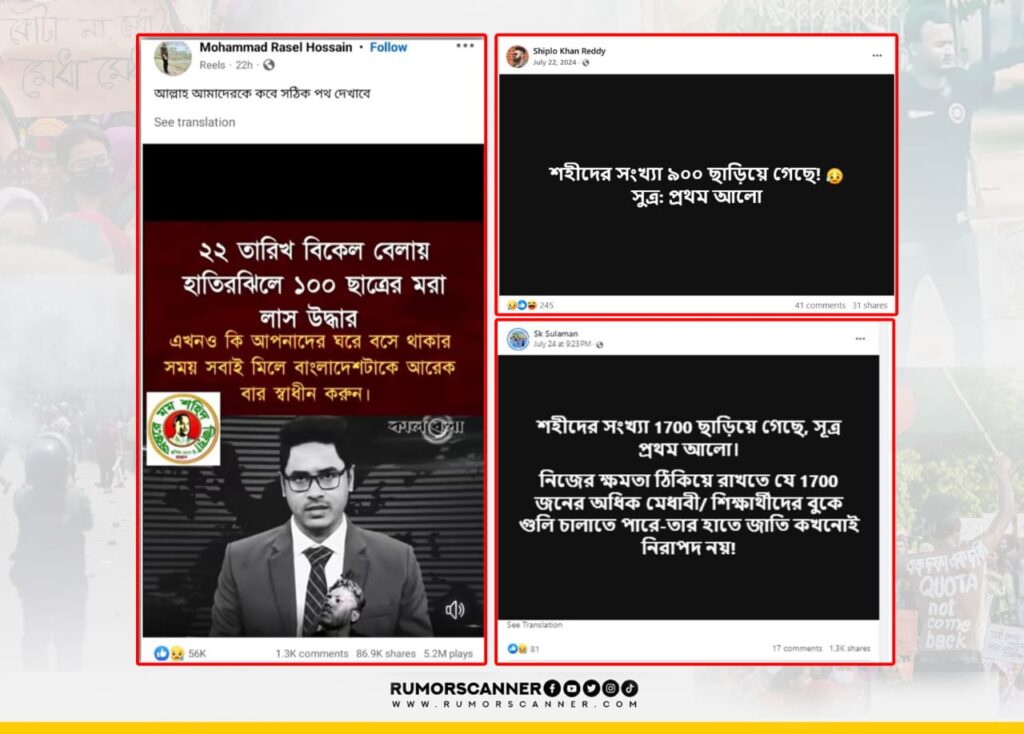
On July 16, at least two claims about women being raped were spread. Some Facebook posts claimed that 27 female students were raped at Dhaka University’s Rokeya Hall. Other posts made the same claim but said it happened at Rokeya University. In reality, none of these events occurred. On the same day, a fake Facebook account named ‘Sanchita Pal Devi’ was used to claim that a supposed Chhatra League leader with that name had openly threatened to gang-rape female quota protesters. In August, a fake Facebook account was created in the name of Chhatra League leader Atika Binte Hossain and used to post offensive content.
On July 17, students vandalized the rooms of Chhatra League members in various university dorms. Following this, a picture was spread on social media claiming that weapons and drugs were found in students’ rooms at a Dhaka University hall. In truth, the weapons and liquor bottles in the picture were found in a room belonging to Chhatra League members at Shahjalal University of Science and Technology in Sylhet. On July 18, an old video of a silent protest performance by a Jagannath University student was shared, with the fake claim that it showed the tragic condition of a Chhatra League leader. This same video has been used to spread false claims again this year.
The amount of this kind of disinformation was constantly increasing, along with baseless claims. For example, on July 27, it was claimed that when six leaders of the quota movement were arrested, 4.5 million taka and nine local weapons were found in their hotel room. This never happened. Disinformation continued even the day before the uprising. On August 4, starting around midnight, fake photo cards designed to look like they were from Jamuna TV and KalBela were used to claim that 20 million taka had been found at the home of Sarjis Alam, who was a coordinator for the Anti-Discrimination Student Movement at the time. Rumor Scanner verified that both of these photo cards were fake.

Rumor Scanner also found that disinformation was spread about various political parties, not just the government and the protesters. On July 17th, a supposed audio clip from 2018 was shared, claiming it was a phone call between BNP leader Amir Khosru Mahmud Chowdhury and a person named Naumi about the anti-quota movement.
The next day, on July 18th, multiple digital banners were posted on Facebook claiming that Bangladesh Jamaat-e-Islami was demanding the cancellation of female quotas, the removal of women from jobs, and a 30% quota for madrasa students. In reality, the party never made any such demands.
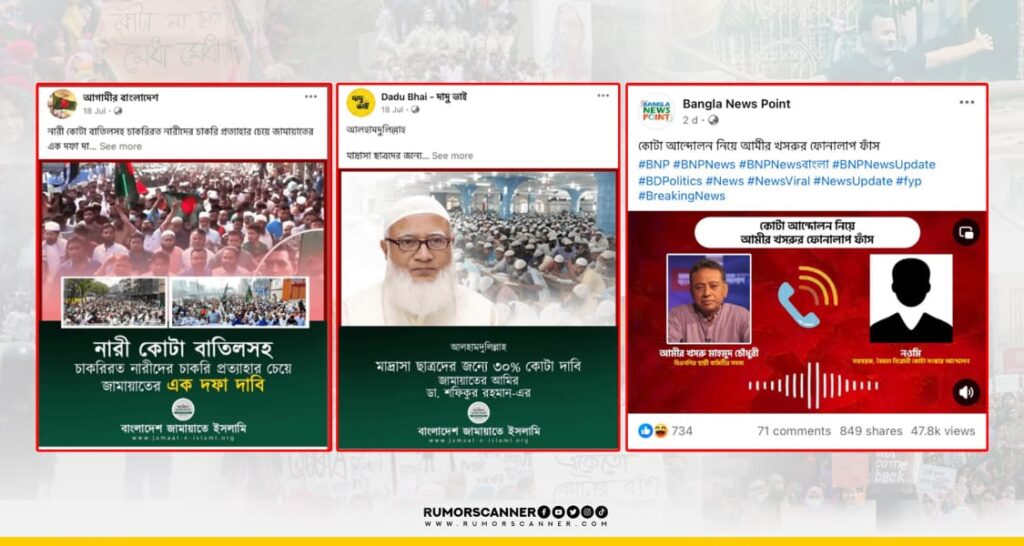
Throughout July, a variety of disinformation tactics were used, often involving foreign personalities and out-of-context video footage. On July 17, fake claims spread that former Bangladesh cricket coach Allan Donald, Bollywood actor Emraan Hashmi, and Indian YouTuber Dhruv Rathee had all posted in support of the protests. The following day, multiple posts claimed that UNESCO would expel the Bangladeshi government if protest-related violence didn’t improve within 72 hours, a statement the organization never made. A video from a foreign news anchor, who was said to be crying over the protest violence, went viral, but it was actually a clip from 2019 of her crying during a report about Syria. On July 27, a fake X account for Italian Ambassador Antonio Alessandro was used to spread a post in support of the students, which was then presented as his official statement. Additionally, on July 25, a video claiming to show Pakistanis marching in solidarity with the protests was actually old footage from a different event in 2022.

Disinformation during the protests also targeted government officials. On July 30, a baseless claim was spread on social media that 100 government officials had refused to observe a national mourning day announced by the government. This claim was completely false.
As the weeks-long protests continued into August, they became a more widespread public movement, and the types of disinformation became more varied. Fake Facebook accounts were used to make false claims of sexual harassment against protesters, an old photo of a Jubo League leader was shared as if he were from the Islami Chhatra Shibir, and fake photo cards were used to spread lies about Chhatra League leaders. For example, on August 3, a fake photo card designed to look like a news report claimed that Chhatra League leaders Saddam and Inan had fled Dhaka wearing burqas. The very next day, another fake photo card, again made to look like a real news outlet, claimed that four Chhatra League leaders—Saddam, Inan, Soikat, and Shayan—had abandoned their political activities and fled to India. Both of these photo cards were fake. Towards the end of the protests, both the government and the protesters were targeted with false claims that they had suspended their planned activities.

Disinformation Spread from Responsible Sources
During the 36 days of continuous protests, not only were regular social media users involved in spreading disinformation, but it also came from some responsible sources. Even several media outlets were found to be promoting false information. For example, on July 11th, a media outlet published a picture with the headline, “Police are beating Comilla University students, and the Proctor is recording a video.” In reality, the person in the picture was not the Proctor but a campus journalist.
The list of media outlets that spread false information includes The Daily Campus (1 instance), Face the People (2 instances), Dhaka Post (1 instance), and Bahannu News (1 instance). Indian media was also active in spreading disinformation. On July 21st, ‘India Today NE’ falsely claimed, “Sheikh Hasina has been moved from her residence in Dhaka to another location. Her current whereabouts remain unknown.” However, she was in Dhaka on that day.
The most surprising source of disinformation came from the U.S. State Department. In a regular press briefing on July 15th, spokesperson Matthew Miller claimed that, according to their information, two people had died in the protests so far. Rumor Scanner immediately contacted the U.S. State Department about this. When asked about the source of the claim, the State Department replied, “We are monitoring the situation and relying on media and communications from Dhaka.” However, no deaths had been reported in the media before Miller’s statement.
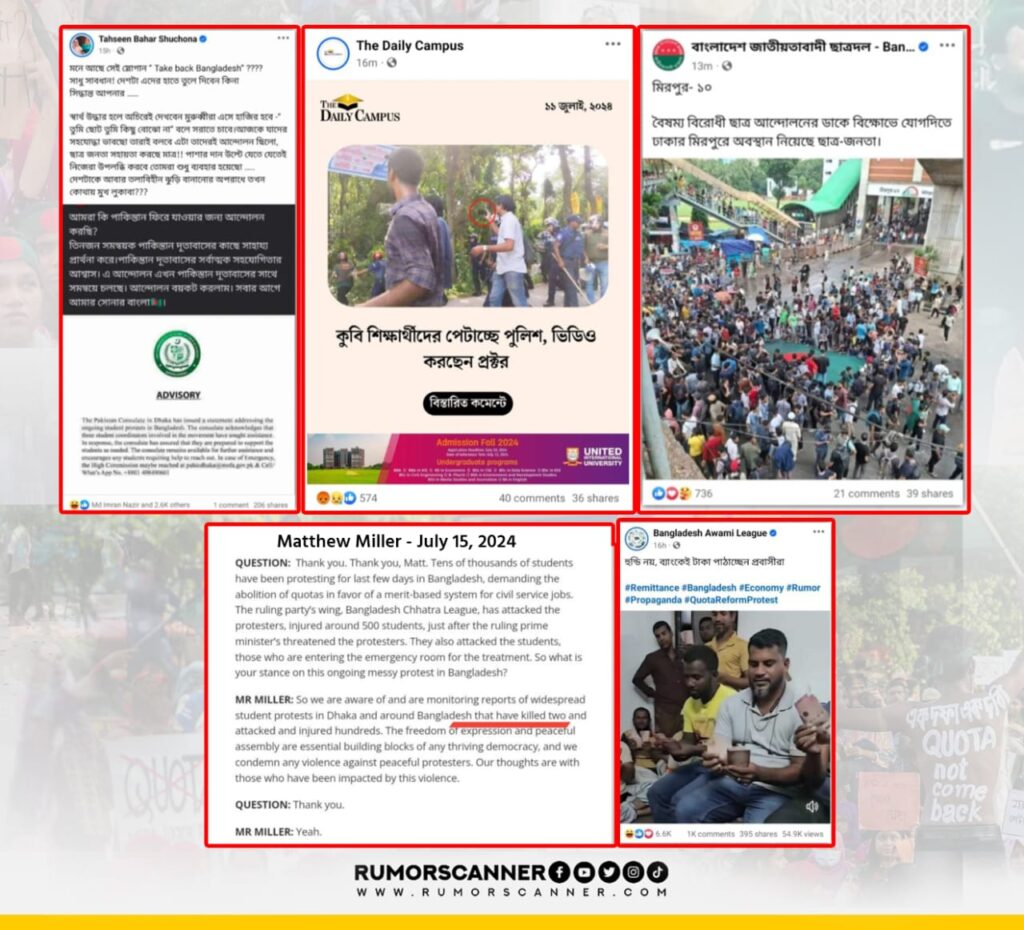
During the protests, disinformation wasn’t just coming from general social media users; it was also being spread by the leading political parties and their social media accounts. Even expatriate Bangladeshis were involved. In support of the protests, they announced they would send money back home through illegal channels (hundi) instead of legal ones (remittance). In response, on July 28, the Awami League’s Facebook page posted a video that showed an employer encouraging his staff to use legal banking channels to send money to Bangladesh. However, an investigation revealed the video was old, from April of the previous year. Rumor Scanner later found at least four more instances of disinformation being spread by the Awami League’s page.
The party’s leaders were also involved. On August 2, Tahsin Bahar Suchona, the then-mayor of Cumilla City Corporation, and Tanvir Hasan Saikat, the general secretary of Dhaka University’s Chhatra League, both shared a fake notice on Facebook. They claimed that the three coordinators of the student movement had asked the Pakistan High Commission for help. An investigation found this notice was a fake, created by editing an actual announcement from the High Commission.
Similarly, the Chhatra Dal’s Facebook page also spread disinformation. On July 29, it posted a picture claiming that student protesters had taken over the Mirpur-10 area of Dhaka. The picture was actually from July 16. On July 31, Dhaka North BNP convener Aminul Haque made a false claim on Facebook, citing ‘Face the People,’ that more than 15 members of the army had resigned. However, ‘Face the People’ had never published this information.
The “Anti-Discrimination Student Movement,” which led the protests, also spread disinformation through its official Facebook group. On August 3, a post with a fake photo card designed to look like it was from RTV claimed that business owners were raising the price of sweets in the capital. RTV had not reported this. Another post in the group and a statement from a coordinator, Nahid Islam, claimed that 12 people had died in an attack in Cumilla on August 3. However, it was confirmed that while many were seriously injured, there were no deaths in the incident.
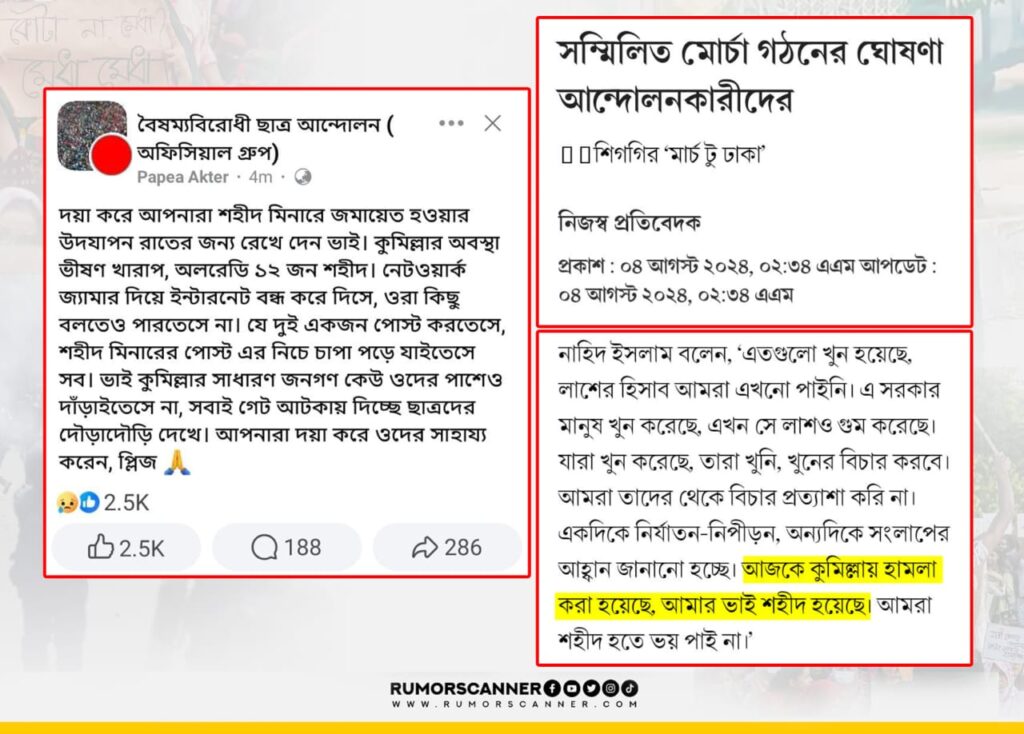
Disinformation Targeted Key Protest Figures
Throughout the protests, the ‘Anti-Discrimination Student Movement’ was regularly targeted by disinformation. For example, on July 22, a fake rumor was spread that Khan Talat Mahmud Rafi, a coordinator from Chittagong University, had died. On the same day, another false claim circulated on social media that Cynthia Jahin Ayesha, the current spokesperson for the organization, had also passed away. Both of these claims were completely untrue.
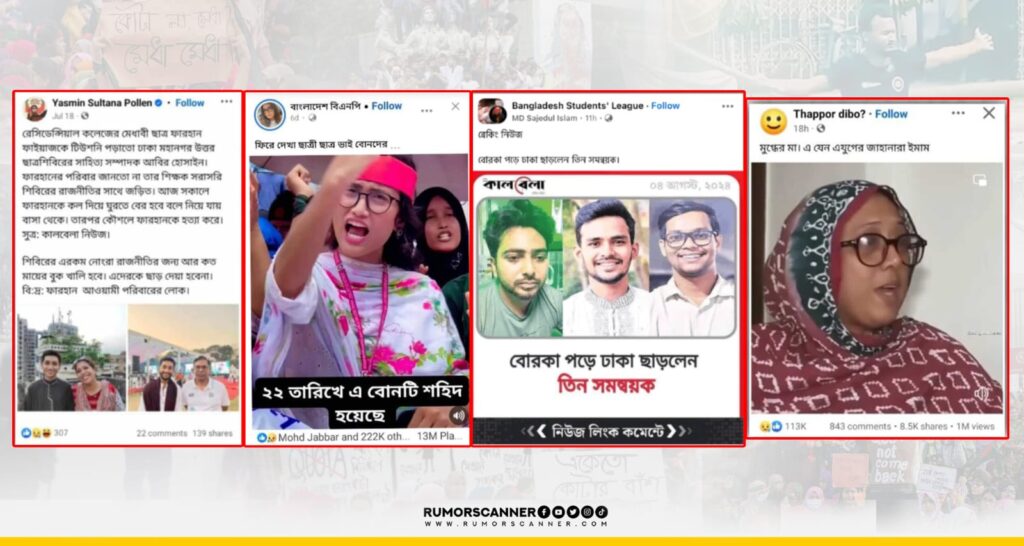
During the protests, a student named Farhan Fayyaz from Dhaka Residential Model College was killed in a clash on July 18. On that day, a false rumor spread, supposedly from the newspaper ‘KalBela,’ claiming that Farhan’s private tutor was a member of the Islami Chhatra Shibir and was involved in his murder. In reality, ‘KalBela’ never published this news. On the same day, another student, Mir Mahfuzur Rahman (Mugdho), was shot and killed in Dhaka. A video of a woman giving an interview was shared widely, with people claiming she was Mugdho’s mother. It was later verified that she was actually the mother of another student who was killed, Tahir Zaman Priyo.
On August 4, a fake photo card designed to look like it was from ‘KalBela’ was circulated. It featured pictures of the three protest coordinators—Nahid Islam, Asif Mahmud, and Baker Mazumder—and a false headline claiming they had fled Dhaka wearing burqas. On that same day, another fake photo card, made to resemble news from Jamuna TV and ‘KalBela,’ was used to spread the false claim that 20 million taka had been found at the home of another coordinator, Sarjis Alam. All of these photo cards were completely fake.
Disinformation Continues Despite Protest Outcome
On August 5, the students and the public achieved their goal. Sheikh Hasina left power, and the movement was a success. However, the spread of disinformation about the protest did not stop there. Even a year after the uprising, Rumor Scanner has continued to find fake news about the movement being shared regularly. Rumor Scanner has identified 33 pieces of disinformation (as of July 31) that were spread after the Awami League government fell.
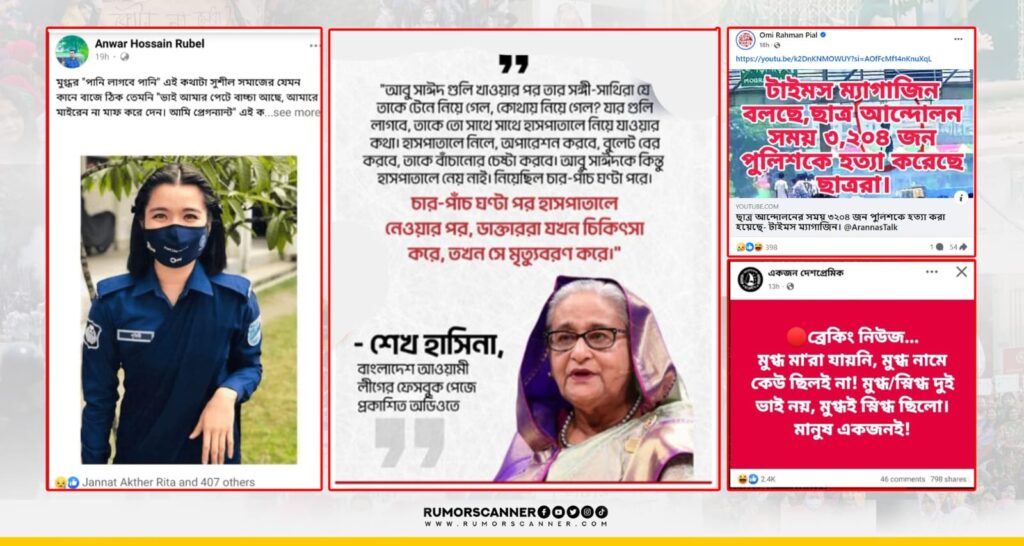
After the August 5th uprising, disinformation continued to be a big problem, and the student Abu Sayed, who was killed in Rangpur, became a major target. It started on August 6th when a video was spread claiming the army was giving him a state funeral, but the video was actually old and had been online before his death. By July 28, Rumor Scanner found at least 13 more pieces of fake news about him, including a false audio recording of Sheikh Hasina on November 23rd from the Awami League’s Facebook page. In the audio, she claimed Abu Sayed was taken to the hospital 4-5 hours after being shot, but Rumor Scanner’s investigation found that he was taken to the hospital very soon after he was shot and arrived by 3 PM.
On November 20, a false claim was made that Mugdho and his brother Snigdho were the same person and that no one named Mugdho had ever existed. This claim was proven to be fake. Soon after the government fell in August, a rumor went viral that a student named Rafiul Islam Rafi had died in Pabna after being shot, and that before he died, he asked for someone to take care of his little sister since he had no father. In reality, Rafi was shot but survived and recovered, his father is alive, and he never made such a request.
In January, an audio recording was spread online, claimed to be a phone call from July between Dhaka University’s current Pro-VC Dr. Mamun Ahmed and BNP leader Tarique Rahman, giving instructions for the protests. However, fact-checking revealed the audio was from 2018.
Disinformation about the police was also repeatedly spread. A common fake claim was that among the 15 police officers killed in Enayetpur on August 4, one was a pregnant female officer who was brutally murdered. This claim used a photo of a female officer. On August 11, Rumor Scanner fact-checked this and found that none of the 15 officers killed were women, and the photo was of a different officer, Prithibi Chakma, who is still alive and working. The same fake claim was spread again in April using an AI-generated photo.
On October 14, the Awami League’s Facebook page falsely claimed that the police and the Ministry of Home Affairs had not released the number of police officers killed in the protests. In fact, the police headquarters had already released a list of 44 officers killed between July 20 and August 14 on August 18. Earlier that month, a different false claim, citing Time magazine, said that 3,204 police officers had been killed by students. Time had never published this information.
From December onwards, Rumor Scanner found three separate fake claims that students who were supposedly killed—Nayan from Bhola, Abdullah Mahbub from Daudkandi, and Rakib from Cumilla University—had actually “returned.” All three of these claims were proven to be completely false.
Constant Effort to Control Disinformation
When a big issue comes up, it naturally leads to rumors. As a fact-checking organization, Rumor Scanner used its past experience to handle the student protests. We were watching the events closely from the start. Our team was ready to quickly get fact-checks to the public. Because publishing a full fact-check on our website takes time, Rumor Scanner used three methods to get the information out faster.
The first method was to post a quick summary of the fact-check directly on social media. For example, when a fake call recording of BNP leader Amir Khosru was spread on July 18, we immediately checked it and posted the summary in our group. However, the full article was not published on our website until July 30.
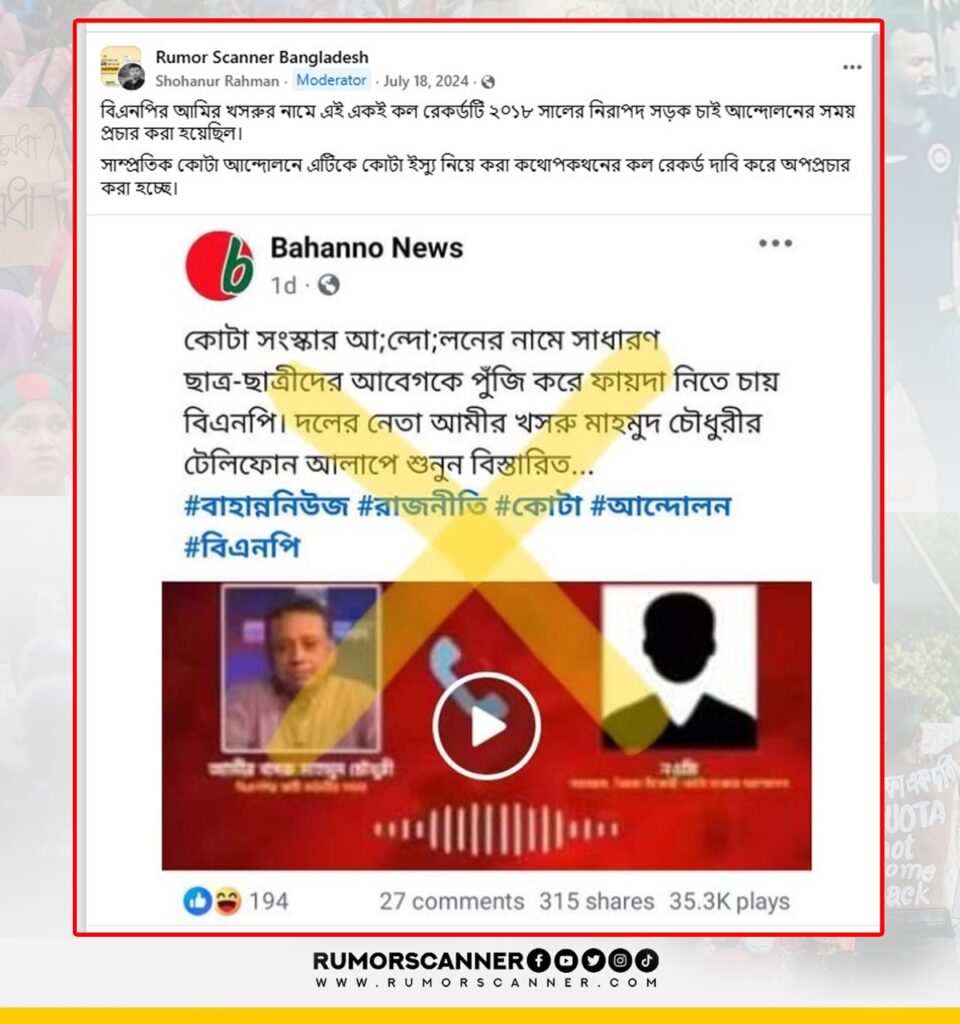
Rumor Scanner didn’t just do fact-checks; it also shared news as needed in its group. For example, on July 16, after confirming the death of Abu Sayed from multiple sources, the news was posted in the group that same afternoon.
Secondly, because the protests became more intense after July 16, Rumor Scanner launched a “Live Update Feed” on its website for the first time to quickly publish fact-checks. This feed was designed to instantly share corrections to false information and to provide other important updates about the movement. The page also kept a daily updated count of the number of deaths in the protest using reliable sources. This live feed remained active until the morning of August 5th.
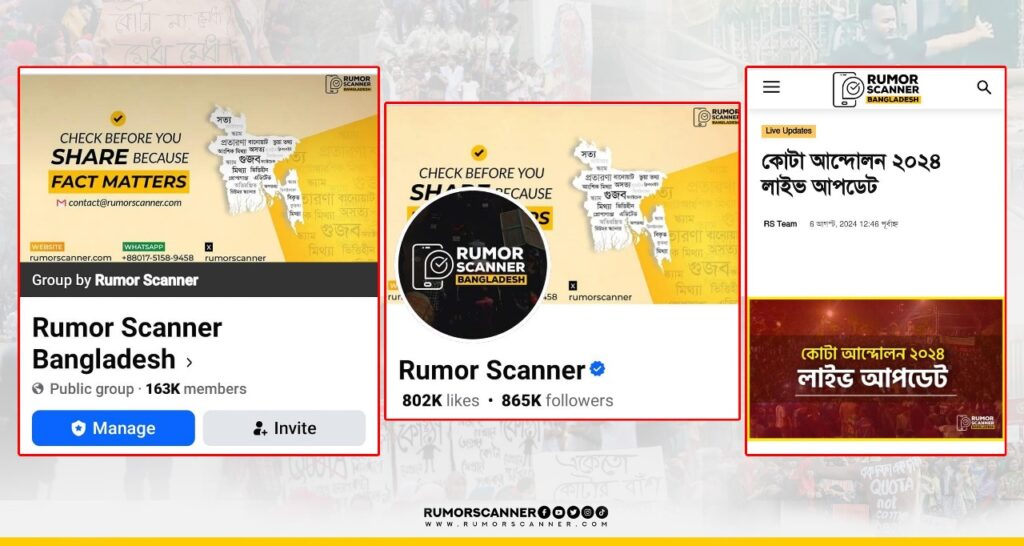
Thirdly, Rumor Scanner changed the traditional format of fact-checks on its website, making it shorter to publish them as quickly as possible.
However, even with these efforts, their fact-checking work was hindered. During the protests in July and August, the internet was shut down at least five times. Sometimes, mobile and broadband internet services were turned off in specific areas, and at other times, it was across the entire country. A recent report from the research organization “Digitally Right” stated that the internet was shut down five times for a total of 22 days between July 15 and August 5. VPN services were also restricted. These internet disruptions made it very difficult for fact-checkers to quickly identify false information.
Methodology
This research is based on reports published on Rumor Scanner’s website. To create this report, we collected data from every related fact-check article published from July 2024 to July of this year, along with information from posts on Rumor Scanner’s Facebook platforms. All of this data was saved in a specific database and then analyzed. To understand the connection between events and claims, we also analyzed news reports from that time. Finally, to make the information easy for readers to understand, we divided it into several parts and presented it using infographics, screenshot collages, and written text.
Main Image in Feature: Zabed Hasnain Chowdhury
Feature Design: Md. Shahajalal Mia






